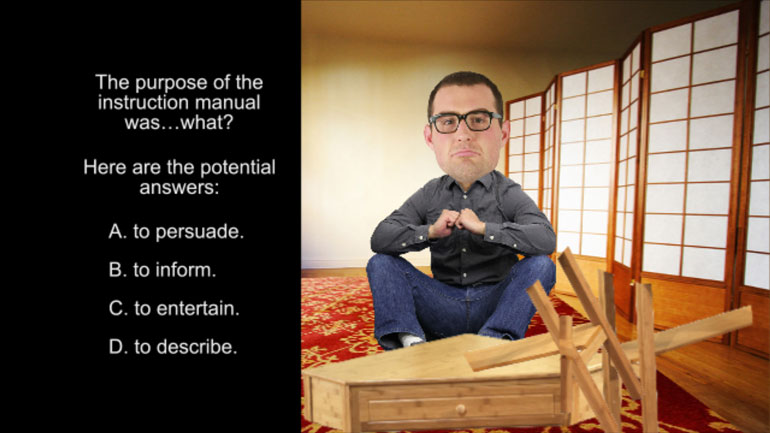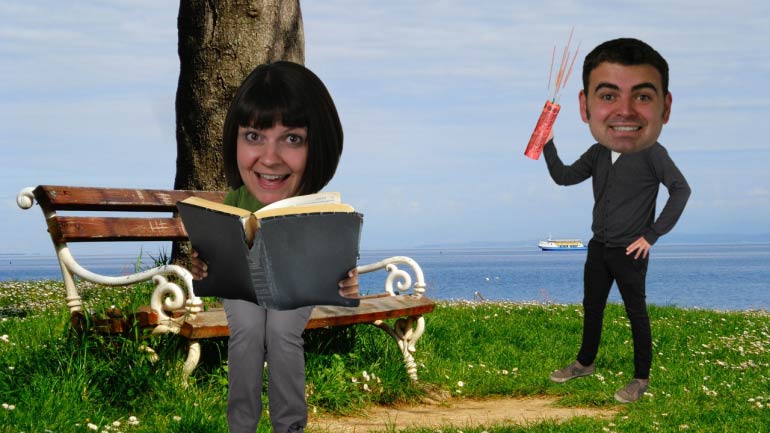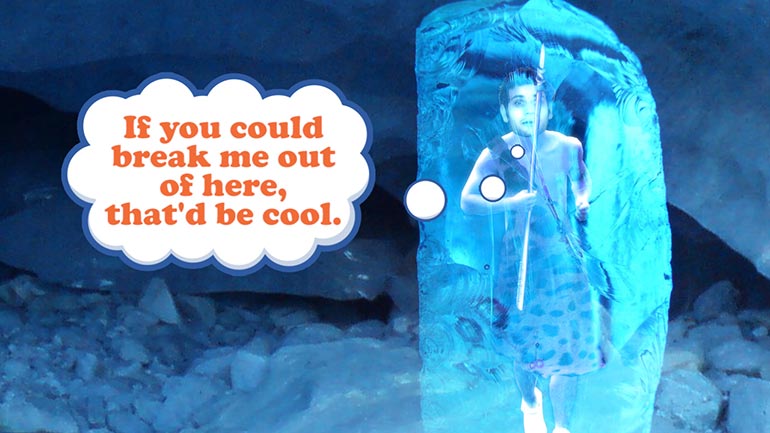ShmoopTube
Where Monty Python meets your 10th grade teacher.
Search Thousands of Shmoop Videos
Science 3: The Rock Cycle 159 Views
Share It!
Description:
Today's lesson is on the rock cycle. Spoiler alert: it's way less effective at getting you to school than a bicycle. There's a reason wheels are made of rubber.
Transcript
- 00:13
Growing up, we tend to classify rocks not by their type, but by their purpose… [Woman holding rocks]
- 00:18
Flat rocks are good for skipping on the lake...
- 00:20
Small rocks are good for waking up your friends in the middle of the night... [Rock smashes into window]
- 00:23
And giant rocks are perfect for showing off how strong you are.
- 00:26
Or sometimes…how not-so-strong you are. But in the world of science, rocks tend to [Man falls to ground holding giant rock]
Full Transcript
- 00:31
be classified into three different types:
- 00:33
Igneous, metamorphic, and sedimentary – and all three have their own specific properties, as well as uses.
- 00:39
Igneous rocks are rocks that were once, well, not so rocky.
- 00:43
Kind of like music, before Elvis hit the scene. [Elvis singing on stage]
- 00:45
But back to the rocks…what we mean by "not so rocky" is that igneous rocks weren't always rocks.
- 00:51
They actually start as liquefied rock, bubbling deep down below the surface of the planet, [Lava bubbling]
- 00:56
where they're melted by the Earth's core.
- 00:58
Once the molten rock comes up to the surface and gets some fresh air, it rapidly cools off. [Molten rock appears from mountain]
- 01:03
And when it does, it turns back into solid rock.
- 01:05
Examples of igneous rock include granite, basalt and obsidian.
- 01:09
And igneous rocks tend to be pretty darn cool looking, which is why they're often used by [Kitchen appears]
- 01:13
interior designers to make things like countertops, backsplashes, sinks, floors, and tabletops.
- 01:18
We heard some designers wanted to use them for mattresses…kinda glad that never caught on. [Girl sleeping on rock mattress]
- 01:22
Next, we've got metamorphic rocks.
- 01:24
These rocks are also created by heat, but they skipped that whole messy "liquefied" phase. [Coop discussing metamorphic rocks]
- 01:29
When a rock is exposed to extreme heat – but not enough heat to straight-up melt it – it
- 01:33
can still be affected by it, and transform into a new, metamorphic type of rock. [Rock goes into super heat machine]
- 01:37
Kind of like when Pokémon evolve, but…way less interesting to watch.
- 01:41
Because so much heat is needed to make them, metamorphic rocks are usually found below [Metamorphic rocks under earths surface]
- 01:45
the earth's surface or near volcanoes. Examples include jade, marble and slate.
- 01:50
Metamorphic rocks have been used in art, sculpture, and construction throughout the history of
- 01:54
humanity – from the Ancient Greeks carving marble statues and columns to roofers using [Ancient greek statue appears]
- 01:58
slate tiles today. Then we've got sedimentary rocks, which are
- 02:02
formed on the surface of the earth when different rock sediments are fused together over time. [Dino discussing sedimentary rocks]
- 02:06
Sedimentary rock is the most common type of rock to be found on the earth's surface, and
- 02:10
include sandstone, amber, and limestone, which does not taste like limes…
- 02:14
Trust us on this one. [Girl at restaurant table with menu]
- 02:15
Since sedimentary rocks are so common and plentiful, we regularly use them in construction
- 02:19
– if something is made from cement, sand, or gravel, well then it's made from sedimentary rocks.
- 02:24
Take one look at a city and you're basically just looking at rearranged sedimentary rocks.
- 02:28
And you thought we were long past the stone age. [Cave man in New York]
- 02:31
Clearly, rocks are essential to human civilization – without them, we'd be living in, well, dirt.
- 02:36
But rocks aren't exactly…perfect.
- 02:38
One of its biggest drawbacks is that natural weather like wind and rain can take its toll [Rock in street being rained on]
- 02:42
on rock, eventually eroding and weathering it.
- 02:45
Buildings can erode...
- 02:46
Ancient art can deteriorate...
- 02:48
And even that gorgeous marble sink might eventually erode from use – though you might need to [Marble sink eroding from water]
- 02:52
give it a few thousand years.
- 02:54
But hey – considering the Earth so generously offered us all of this amazing rock for free,
- 02:58
we probably shouldn't be complaining.
Up Next
ELA Drills, Beginner: Point of View. Is the statement in the video true or false?
Related Videos
ELA Drills, Beginner: Textual Analysis 1. The purpose of the instruction manual was...what?
ELA Drills, Beginner: Point of View 3. Which sentence in the passage best shows the narrator's point of view on the topic of Chelsea Simpson?
We wanted to make a video about sedentary rocks, but we couldn't get lazy uncle Rocky off the couch. Oh well. We'll teach you about sedimentary roc...
Today we're bringing you the opposite of Jurassic Park—how living things become fossils. Okay okay, it might not be quite as fun...but hey, at le...




